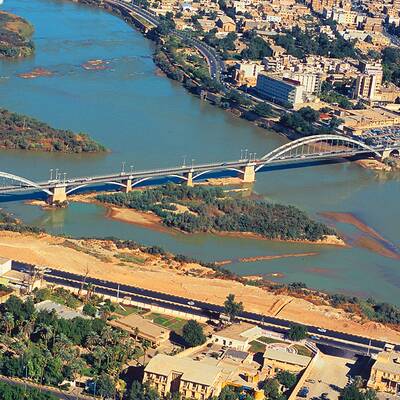
Khuzestan’s Sword Dance
Sword dance is one of the most important Arab’s dances among the Khuzestan’s people with some sword movements, clothes and folk music evoking the rhythmic movements of sea waves. Arabic sword is one of the most popular and most beautiful swords in the world which is especially valuable for the people of this nation from the past up to the present and they know it, not only as a war instrument but also as a symbol of brotherhood, chivalry, strength and peace, so that there were some special traditions for taking it. During the last hundred years, Khuzestan sword dance, driven from the nature and the geographical location, has been performed by groups, on the horseback and in outdoor among the Iran’s Arab tribes. Dancing, fencing and horseback riding were regularly common in highly worthwhile ceremonies among Arab tribes of Khuzestan specially wedding parties, events, feasts specially Eid-al-Fitr and Eid-e-Qurban.
Khuzestan province with its ethnic diversity is the place of intersection and unity of various cultures, each one manifests its unique culture by aide of a certain style of costume, music, dance and traditions despite of their mutual influence on each other; however, the sword dance is best-known as the most prominent dance in this region.
To perform the sword dance, dancers dressed in a long local white costume known as Deshdashe, Chafieyh (A kind of headband in white, black or green color) and Eqal (rings woven from yarn which keeps Chafiye) on their head stand in a group side by side in form of a barrier to protect their homeland. The rhythm in this dance starts moderately and it becomes faster increasingly; dancers move forward and are divided into two groups.
Both groups stand in front of the each other and start to move their neck forward; This movement has been inspired by the eagle movement when he is waiting to for right time to hunt. They perceived eagle as the symbol of freedom flying to everywhere and never eat the animal carcass.
A different dance
Sword dance which is done among khuzestan’s Arab tribes and is completely different from what is done in Persian Gulf countries so that the only common theme between them is sword which the dancers use (The Emirate's Arabs neck movement backward is based on the camel movement as the symbol of perseverance). In this way, both groups attack each other with this movement and the battle starts .After the battle, the dancers put their sword on their shoulders and they rotate two times with 360 degrees; it means to look on their surrounding world.
After the spin, the dancers of both groups stand side by side and raise their swords as the symbol of ceasefire and the end of battle and shake each other's hands to show the unity and friendship. They turn around each other and perform dramatic gestures which means the peace and friendship among the opposing groups.
At the end of the dance, the dancers stand in a queue, behind the older person of the group and turn across the square and return to their first place meaning that they return to the peaceful life and finish the war. Certain poetries based on the type of event are sung with sword dance so that the symbols of happiness, epic and sometimes mourning are seen in the used music, sound and movements in different situations.
.jpg)
